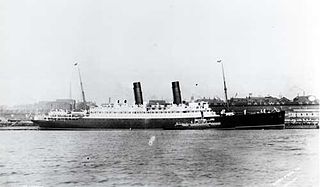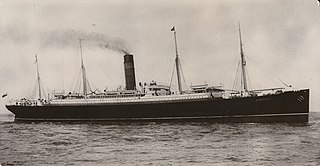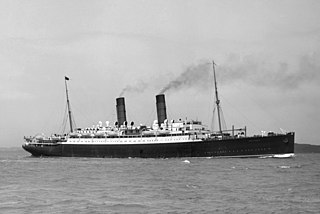See also
- TSMS Lakonia, a Greek ocean liner burnt out and sunk in December 1965
A number of ships have been named Laconia
Two different ocean liners of the Cunard Steamship Lines have been named RMS Laconia. Although one was launched ten years after the other, and was the subject of a TV movie, they are easily confused; they had similar careers, looked the same, and met similar fates.

An ocean liner is a type of passenger ship primarily used for transportation across seas or oceans. Ocean liners may also carry cargo or mail, and may sometimes be used for other purposes. Only one ocean liner remains in service today.

RMS Laconia was a Cunard ocean liner built by Swan Hunter & Wigham Richardson, launched on 27 July 1911, with the wife of the U.S. Ambassador Mrs. Whitelaw Reid christening the vessel. Laconia was delivered to the Cunard Line on 12 December 1911, and began service on 20 January 1912. She was the first Cunard ship of that name. She was torpedoed and sunk on 25 February 1917 during World War I; 12 passengers were killed.

RMS Laconia was a Cunard ocean liner, built by Swan, Hunter & Wigham Richardson as a successor of the 1911–1917 Laconia. The new ship was launched on 9 April 1921, and made her maiden voyage on 25 May 1922 from Southampton to New York City. At the outbreak of the Second World War she was converted into an armed merchant cruiser, and later a troopship. She was sunk in the South Atlantic Ocean on 12 September 1942 by torpedoes. Like her predecessor, sunk during the First World War, this Laconia was also destroyed by a German submarine. Some estimates of the death toll have suggested that over 1,658 people were killed when the Laconia sank. The U-boat commander Werner Hartenstein then staged a dramatic effort to rescue the passengers and the crew of Laconia, which involved additional German U-boats and became known as the Laconia incident.
Two ocean liners of the Cunard Line have been named RMS Mauretania, after the ancient territory of Mauretania:
SS America may refer to:
Several ships have been named Niagara. They include:

RMS Carpathia was a Cunard Line transatlantic passenger steamship built by Swan Hunter & Wigham Richardson in their shipyard in Wallsend, England.
RMS Andania was a British ocean liner launched in 1921. She was the first of six 14,000-ton "A"-class liners built for the Cunard Line in the early 1920s. The other ships were Antonia, Ausonia, Aurania, Ascania, and Alaunia.
The following ships are named Queen Mary:

RMS Alaunia was an ocean liner owned by the Cunard Line. She was built in 1913 at Greenock and measured 13,405 tons gross. She was one of the three ships Cunard ordered Scotts Shipbuilding and Engineering Company to build. These three ships were RMS Andania, Alaunia, and RMS Aurania. The Alaunia was the second of these three ships. She and her sisters had only 2nd class and 3rd class.
Empress of Britain may refer to one of these Canadian Pacific Steamship Company ocean liners:

SS Ivernia was a British ocean liner owned by the Cunard Line, built by the company Swan Hunter & Wigham Richardson of Newcastle upon Tyne, England, and launched in 1899. The Ivernia was one of Cunard's intermediate ships, that catered to the vast immigrant trade. Together with her sister ship RMS Saxonia, the Ivernia worked on Cunard's service from Liverpool to Boston and then later on the immigrant run the Cunard Line had established from Fiume and Trieste to New York City.

A four-funnel liner, also known as a four-stacker, is an ocean liner with four funnels.
RMS Franconia may refer to the following specific vessels:

The RMS Franconia was an ocean liner operated by the Cunard Line. She was launched on 23 July 1910 at the Swan, Hunter & Wigham Richardson Wallsend shipyard. Franconia was intended for the line's Boston service, being the largest ship of the time to enter Boston harbor, with winter service in the New York-Mediterranean cruising service.
SS Transylvania may refer to:

Captain William Thomas Turner was a British merchant navy captain. He is best known as the captain of RMS Lusitania when she was sunk by a German torpedo in May 1915.
A number of steamships were named Magdalena: